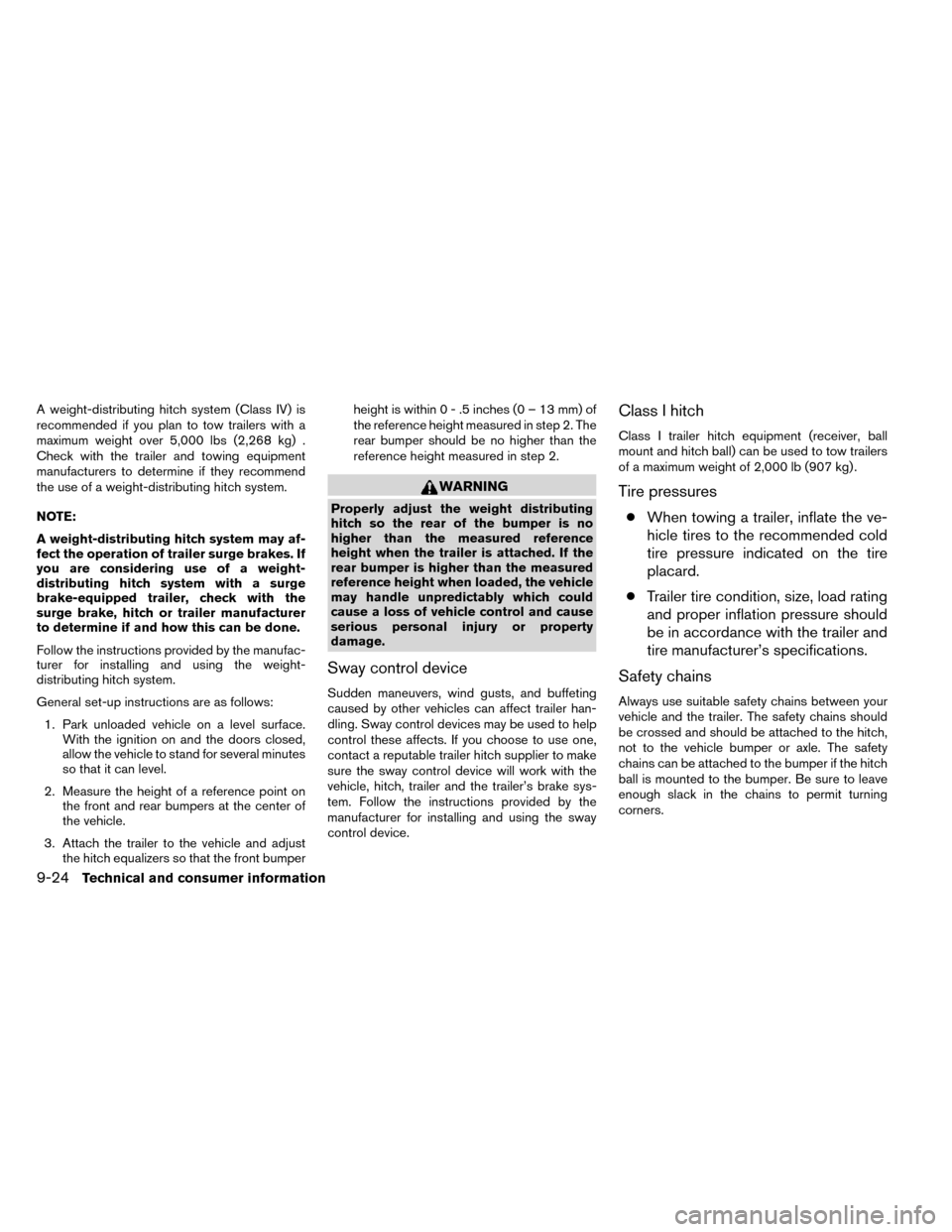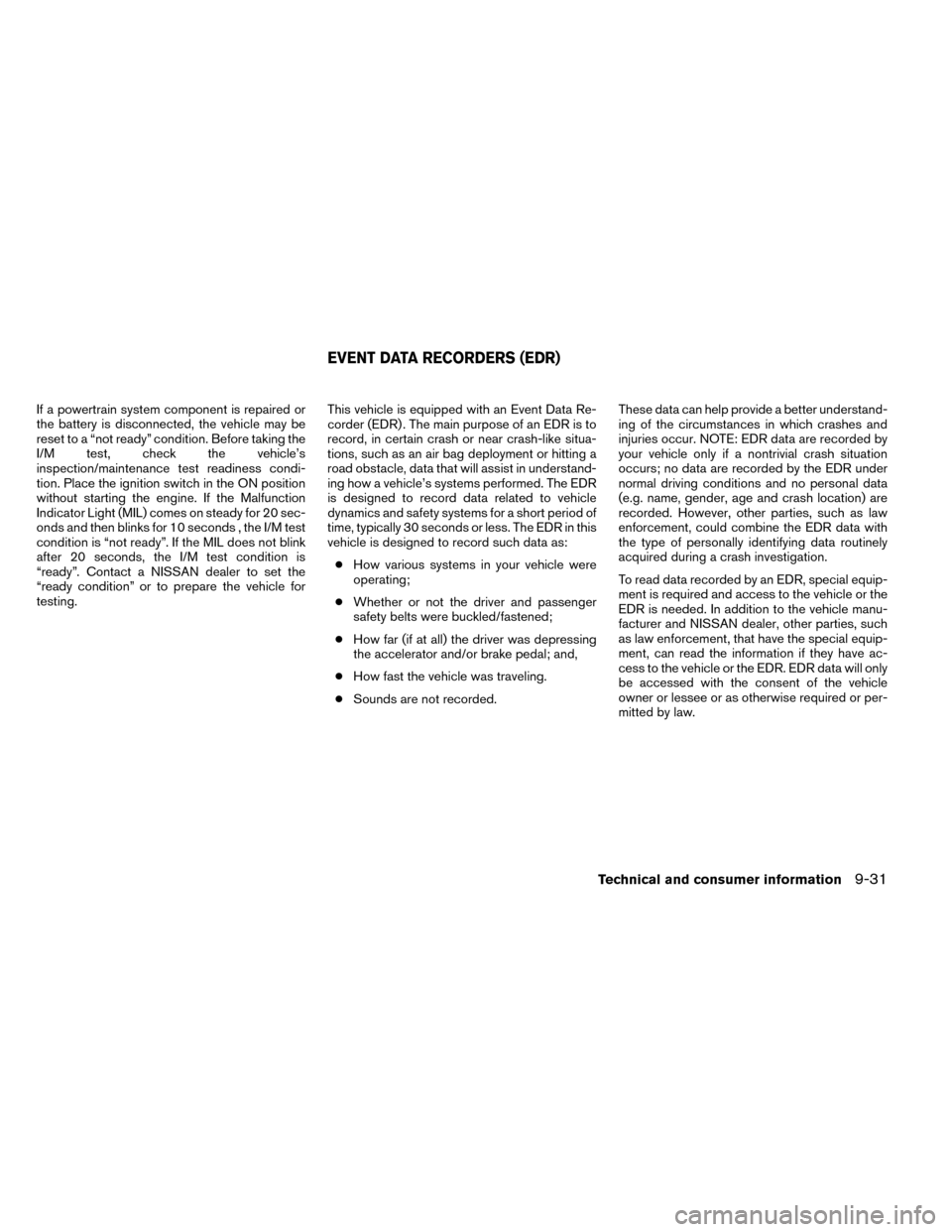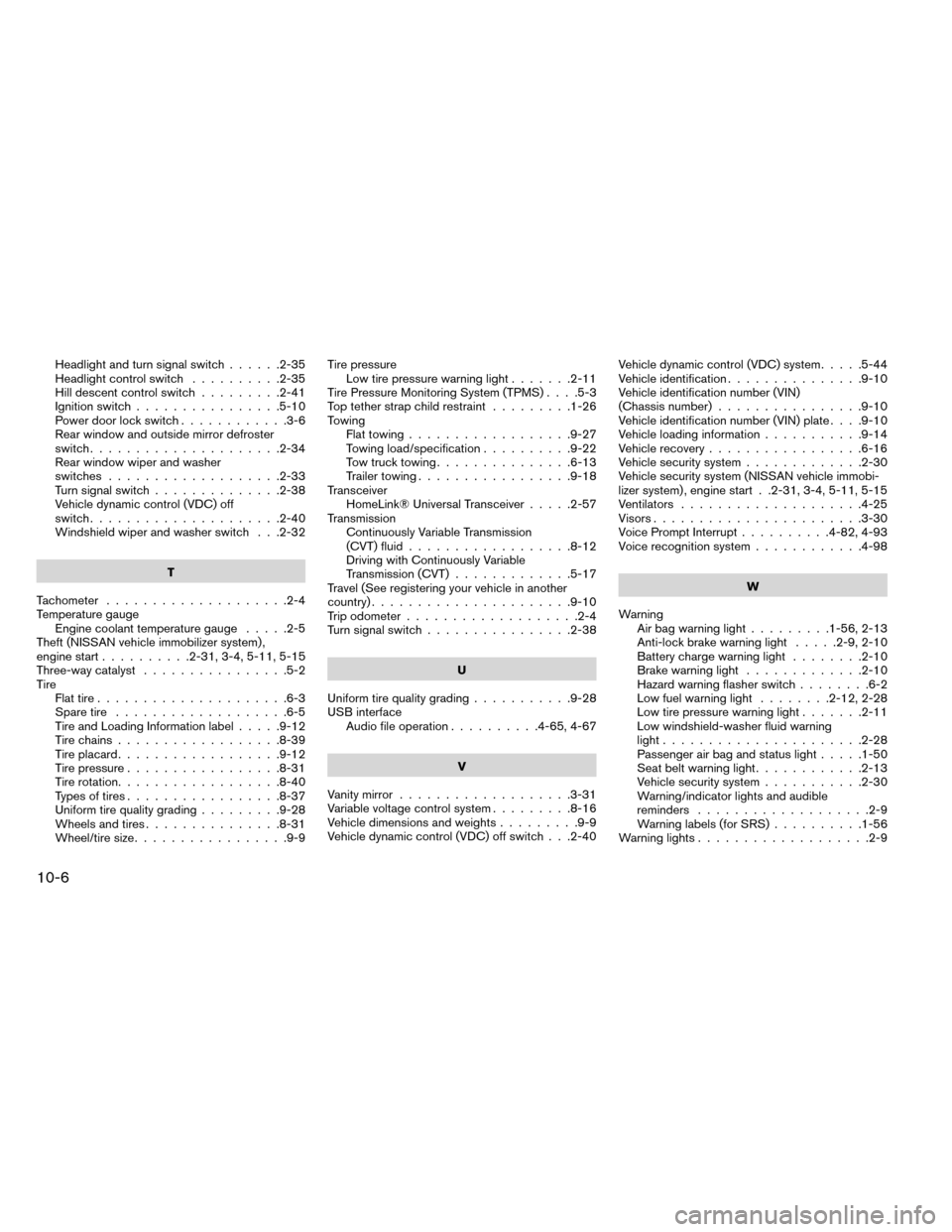2014 NISSAN ROGUE ignition
[x] Cancel search: ignitionPage 425 of 442

A weight-distributing hitch system (Class IV) is
recommended if you plan to tow trailers with a
maximum weight over 5,000 lbs (2,268 kg) .
Check with the trailer and towing equipment
manufacturers to determine if they recommend
the use of a weight-distributing hitch system.
NOTE:
A weight-distributing hitch system may af-
fect the operation of trailer surge brakes. If
you are considering use of a weight-
distributing hitch system with a surge
brake-equipped trailer, check with the
surge brake, hitch or trailer manufacturer
to determine if and how this can be done.
Follow the instructions provided by the manufac-
turer for installing and using the weight-
distributing hitch system.
General set-up instructions are as follows:1. Park unloaded vehicle on a level surface. With the ignition on and the doors closed,
allow the vehicle to stand for several minutes
so that it can level.
2. Measure the height of a reference point on the front and rear bumpers at the center of
the vehicle.
3. Attach the trailer to the vehicle and adjust the hitch equalizers so that the front bumper height is within0-.5inches (0 – 13 mm) of
the reference height measured in step 2. The
rear bumper should be no higher than the
reference height measured in step 2.
WARNING
Properly adjust the weight distributing
hitch so the rear of the bumper is no
higher than the measured reference
height when the trailer is attached. If the
rear bumper is higher than the measured
reference height when loaded, the vehicle
may handle unpredictably which could
cause a loss of vehicle control and cause
serious personal injury or property
damage.
Sway control device
Sudden maneuvers, wind gusts, and buffeting
caused by other vehicles can affect trailer han-
dling. Sway control devices may be used to help
control these affects. If you choose to use one,
contact a reputable trailer hitch supplier to make
sure the sway control device will work with the
vehicle, hitch, trailer and the trailer’s brake sys-
tem. Follow the instructions provided by the
manufacturer for installing and using the sway
control device.
Class I hitch
Class I trailer hitch equipment (receiver, ball
mount and hitch ball) can be used to tow trailers
of a maximum weight of 2,000 lb (907 kg) .
Tire pressures
● When towing a trailer, inflate the ve-
hicle tires to the recommended cold
tire pressure indicated on the tire
placard.
● Trailer tire condition, size, load rating
and proper inflation pressure should
be in accordance with the trailer and
tire manufacturer’s specifications.
Safety chains
Always use suitable safety chains between your
vehicle and the trailer. The safety chains should
be crossed and should be attached to the hitch,
not to the vehicle bumper or axle. The safety
chains can be attached to the bumper if the hitch
ball is mounted to the bumper. Be sure to leave
enough slack in the chains to permit turning
corners.
9-24Technical and consumer information
Page 432 of 442

If a powertrain system component is repaired or
the battery is disconnected, the vehicle may be
reset to a “not ready” condition. Before taking the
I/M test, check the vehicle’s
inspection/maintenance test readiness condi-
tion. Place the ignition switch in the ON position
without starting the engine. If the Malfunction
Indicator Light (MIL) comes on steady for 20 sec-
onds and then blinks for 10 seconds , the I/M test
condition is “not ready”. If the MIL does not blink
after 20 seconds, the I/M test condition is
“ready”. Contact a NISSAN dealer to set the
“ready condition” or to prepare the vehicle for
testing.This vehicle is equipped with an Event Data Re-
corder (EDR) . The main purpose of an EDR is to
record, in certain crash or near crash-like situa-
tions, such as an air bag deployment or hitting a
road obstacle, data that will assist in understand-
ing how a vehicle’s systems performed. The EDR
is designed to record data related to vehicle
dynamics and safety systems for a short period of
time, typically 30 seconds or less. The EDR in this
vehicle is designed to record such data as:
● How various systems in your vehicle were
operating;
● Whether or not the driver and passenger
safety belts were buckled/fastened;
● How far (if at all) the driver was depressing
the accelerator and/or brake pedal; and,
● How fast the vehicle was traveling.
● Sounds are not recorded. These data can help provide a better understand-
ing of the circumstances in which crashes and
injuries occur. NOTE: EDR data are recorded by
your vehicle only if a nontrivial crash situation
occurs; no data are recorded by the EDR under
normal driving conditions and no personal data
(e.g. name, gender, age and crash location) are
recorded. However, other parties, such as law
enforcement, could combine the EDR data with
the type of personally identifying data routinely
acquired during a crash investigation.
To read data recorded by an EDR, special equip-
ment is required and access to the vehicle or the
EDR is needed. In addition to the vehicle manu-
facturer and NISSAN dealer, other parties, such
as law enforcement, that have the special equip-
ment, can read the information if they have ac-
cess to the vehicle or the EDR. EDR data will only
be accessed with the consent of the vehicle
owner or lessee or as otherwise required or per-
mitted by law.
EVENT DATA RECORDERS (EDR)
Technical and consumer information9-31
Page 436 of 442

G
Garage door opener, HomeLink® Universal
Transceiver ....................2-57
Gascap .....................3-27
Gauge Engine coolant temperature gauge .....2-5
Fuel gauge ...................2-5
Odometer ...................2-4
Speedometer .................2-4
Tachometer ..................2-4
Trip odometer .................2-4
General maintenance ...............8-2
Glovebox.....................2-47
Gloveboxlock..................2-47
H
Hands-free phone system,
Bluetooth®................4-79,4-91
Hazard warning flasher switch ..........6-2
Headlight and turn signal switch ........2-35
Headlight control switch ............2-35
Headlights ....................8-27
Head restraints Active Head Restraint .............1-6
Headrests ...................1-6
Heated seats ...................2-39
Heater Heater and air conditioner
controls................4-26,4-35
Heater operation ...........4-28,4-36
Hill descent control switch ...........2-41
Hill descent control system ...........5-48Hill start assist system
..............5-49
HomeLink® Universal Transceiver .......2-57
Hood release ...................3-22
Hook Luggage hook ................2-48
Horn .......................2-38
I
Ignition switch ..................5-10
Ignition Switch Push-Button Ignition Switch ........5-12
Immobilizer system ......2-31,3-4,5-11,5-15
Important vehicle information label .......9-11
In-cabin microfilter ................8-18
Increasing fuel economy .............5-37
Indicator lights and audible reminders
(See warning/indicator lights and audible
reminders) .....................2-9
Inside automatic anti-glare mirror ........3-32
Inside mirror ...................3-31
Instrument brightness control ..........2-37
Instrument panel ...............0-6,2-2
Instrument panel dimmer switch ........2-37
Intelligent Key system Key operating range .............3-12
Key operation ................3-14
Mechanical key ................3-4
Remote keyless entry operation.......3-17
Troubleshooting guide ............3-20
Warning signals ...............3-20
Interiorlight....................2-55
iPod® Player ...............4-68,4-70
ISOFIX child restraints .............1-24 J
Jump starting ...................6-10
K
Keyfob battery replacement ...........
8-24
Keyless entry With Intelligent Key system
(See Intelligent Key system) .........3-17
Keyless entry system
(See remote keyless entry system) ........3-2
Keys, For Intelligent Key system ......3-2,3-11
L
Labels Air conditioner specification label .....9-12
C.M.V.S.S. certification label ........9-11
Emission control information label .....9-11
Engine serial number ............9-11
F.M.V.S.S. certification label .........9-11
Tire and Loading Information label .....9-12
Vehicle identification number (VIN) plate . .9-10
Warning labels (for SRS) ..........1-56
LATCH (Lower Anchors and Tethers for CHildren)
System ......................1-24
License plate Installing the license plate ..........9-13
Liftgate......................3-23
Lift gate release .................3-26
Light Airbagwarninglight.........1-56,2-13
Brakelight(Seestoplight).........8-28
10-3
Page 439 of 442

Headlight and turn signal switch......2-35
Headlight control switch ..........2-35
Hill descent control switch .........2-41
Ignition switch ................5-10
Power door lock switch ............3-6
Rear window and outside mirror defroster
switch.....................2-34
Rear window wiper and washer
switches ...................2-33
Turn signal switch ..............2-38
Vehicle dynamic control (VDC) off
switch.....................2-40
Windshield wiper and washer switch . . .2-32
T
Tachometer ....................2-4
Temperature gauge Engine coolant temperature gauge .....2-5
Theft (NISSAN vehicle immobilizer system) ,
engine start ..........2-31,3-4,5-11,5-15
Three-waycatalyst ................5-2
Tire Flat tire .....................6-3
Spare tire ...................6-5
Tire and Loading Information label .....9-12
Tire chains ..................8-39
Tire placard ..................9-12
Tire pressure .................8-31
Tirerotation..................8-40
Types of tires .................8-37
Uniform tire quality grading .........9-28
Wheels and tires ...............8-31
Wheel/tire size .................9-9 Tire pressure
Low tire pressure warning light .......2-11
Tire Pressure Monitoring System (TPMS) ....5-3
Toptetherstrapchildrestraint .........1-26
Towing Flattowing..................9-27
Towing load/specification ..........9-22
Towtrucktowing...............6-13
Trailertowing.................9-18
Transceiver HomeLink® Universal Transceiver .....2-57
Transmission Continuously Variable Transmission
(CVT) fluid ..................8-12
Driving with Continuously Variable
Transmission (CVT) .............5-17
Travel (See registering your vehicle in another
country) ......................9-10
Trip odometer ...................2-4
Turn signal switch ................2-38
U
Uniform tire quality grading ...........9-28
USB interface Audio file operation ..........4-65,4-67
V
Vanity mirror ...................3-31
Variable voltage control system .........8-16
Vehicle dimensions and weights .........9-9
Vehicle dynamic control (VDC) off switch . . .2-40 Vehicle dynamic control (VDC) system
.....5-44
Vehicle identification ...............9-10
Vehicle identification number (VIN)
(Chassis number) ................9-10
Vehicle identification number (VIN) plate ....9-10
Vehicle loading information ...........9-14
Vehicle recovery .................6-16
Vehicle security system .............2-30
Vehicle security system (NISSAN vehicle immobi-
lizer system) , engine start . .2-31, 3-4, 5-11, 5-15
Ventilators ....................4-25
Visors.......................3-30
Voice Prompt Interrupt ..........4-82,4-93
Voice recognition system ............4-98
W
W
arning Airbagwarninglight.........1-56,2-13
Anti-lock brake warning light .....2-9,2-10
Battery charge warning light ........2-10
Brakewarninglight .............2-10
Hazard warning flasher switch ........6-2
Lowfuelwarninglight ........2-12,2-28
Low tire pressure warning light .......2-11
Low windshield-washer fluid warning
light......................2-28
Passenger air bag and status light .....1-50
Seat belt warning light ............2-13
Vehicle security system ...........2-30
Warning/indicator lights and audible
reminders ...................2-9
Warning labels (for SRS) ..........1-56
Warninglights...................2-9
10-6